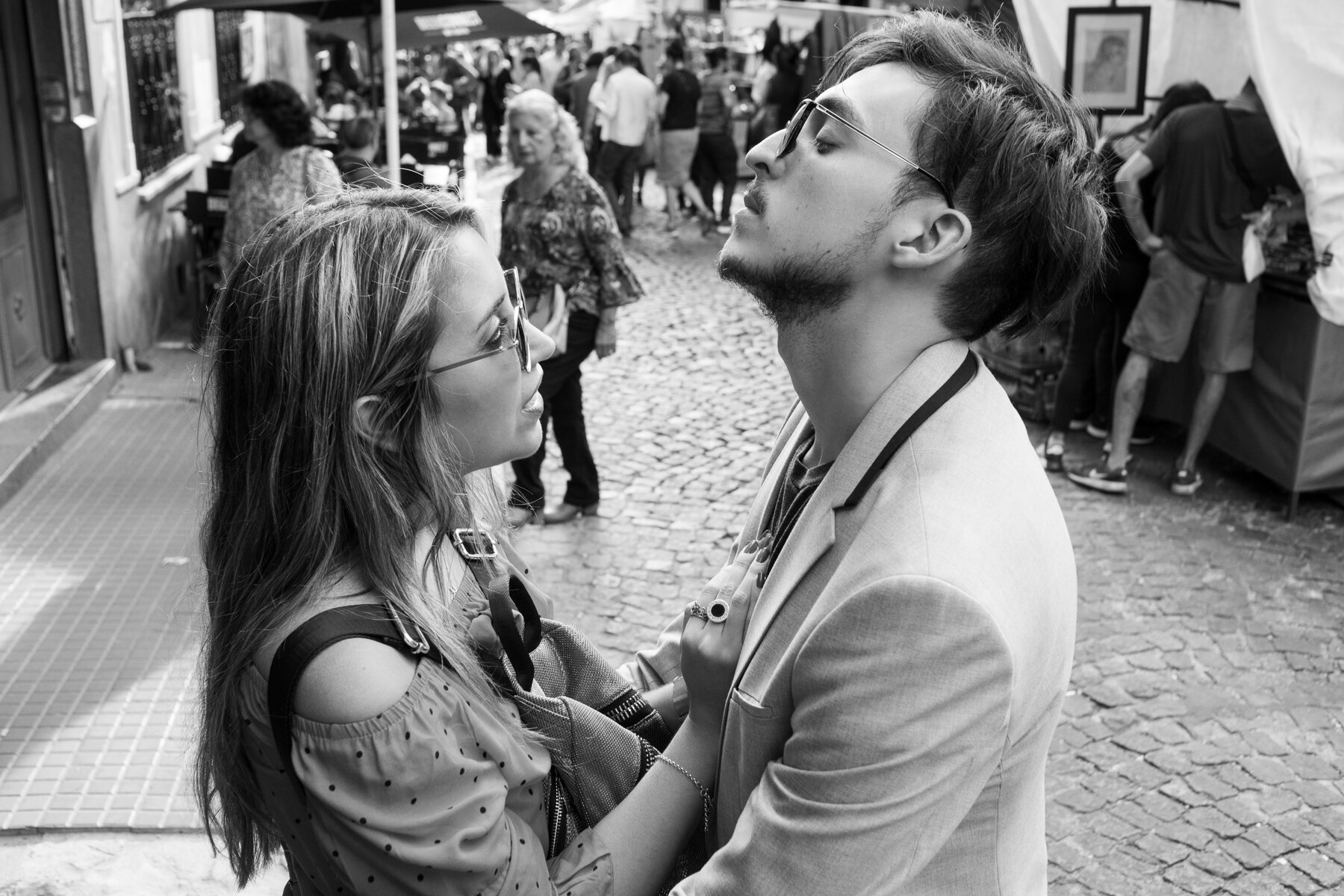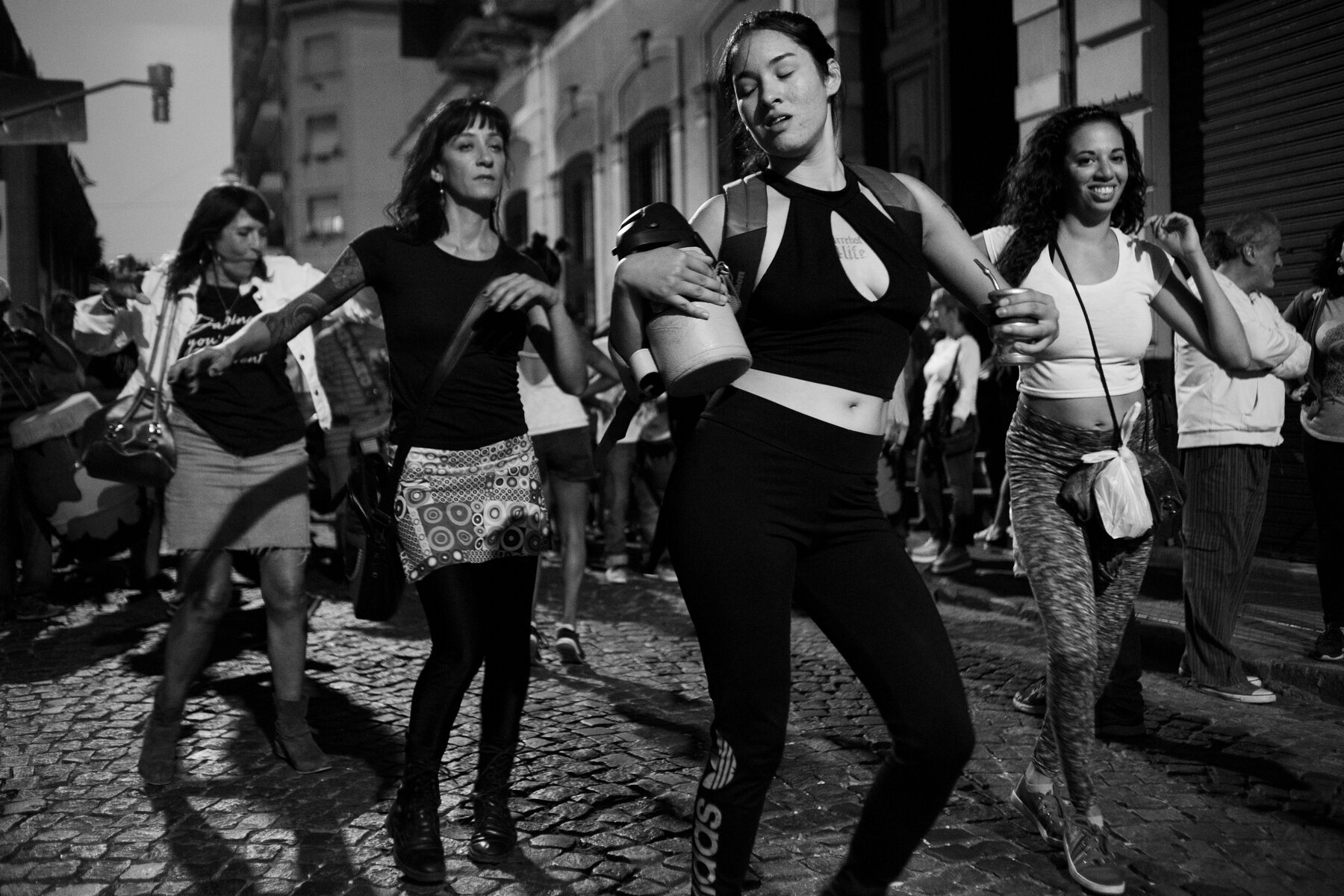
Couple at the Feria de San Telmo. Humberto 1o

Friends. Parque Lezama

Dancers spearheading a Yacumenza band. Defensa

Community tango. Plaza Dorrego

Tire shop. Independencia

Another tire shop. Independencia

Man carrying crates. Cochabamba

Marcelo at salvage work. Salvage workers traverse the streets and retrieve cardboard and other salvagable materials and items from trash receptacles and local businesses. Marcelo collects 60-70 kilos of paper and cardboard per day, which has a salvage value of 5 pesos per kilo at the time. With other salvage items he makes 600-700 pesos per day. The official exchange rate was about 38 pesos per US dollar at the time; the unofficial exchange rate was at 55-60 per US dollar due to legal exchange restrictions. Defensa y San Juan

A boy scrutinizing a man who is losing a checkers game. Parque Lezama

Commuter. Independencia

Woman during morning prayer at a Mother Teresa statue. Parque Lezama

Two men of a congregation praying for a stranger. Parque Lezama

Drawing artist following a Yacumenza band. Defensa

Tango dancers. Plaza Dorrego

Madres de la plaza arriving on the plaza by bus to celebrate the anniversary of the end of the military dictatorship their protests helped end in the 1980s. Characteristically, the mothers wear head scarves with the names of their abducted children—the detenidos/desaparecidos. The madres de la plaza and the iconography of their head scarves are widely recognized as symbols of peaceful protest against tyranny in South America, where many countries share a history of military dictatorships. Plaza de Mayo

Images of some of the 30,000 detenidos/desaparecidos abducted during the military dictatorship on the wall of the Colegio Nacional de Buenos Aires. Bolívar

Porteños waiting for passers-by. Defensa

Inflation. With more than fifty percent inflation year on year, prices (have to) change frequently. This image shows what economists call menu costs: the costs of changing prices. Here they are on display literally in the form of a restaurant owner changing the prices, but not the items, on her chalkboard menu. Coincidentally, the TV reads (in Spanish): "This transfer, too, has a very high price tag; something like US$ 80k." Independencia

Riot police storming Defensa during the artist/artisan protest. Defensa y Independencia

Protester in front of riot police during the artist/artesan protest. Defensa y Chile

Artist/artesan rally on the weekend following the riot and the storming of Defensa by police. Defensa near Independencia

Old pick-up truck. Avenida Ing Huergo

Piquetero (laborer) rally. Parque Lezama

Dog under sales stand. Parque Lezama

Gas Station. Chile

Used furniture store. Cochabamba

The Museum of National History. Parque Lezama

Parking garage. Tacuarí

Poor boy exiting a café. Defensa y Humberto 1o

View towards la Boca. Parque Lezama

Ricky and his buddy enjoying Sunday night. Bethlem y Defensa

Boy and dog of the conventillo. Balcarce y Moreno

Lovers dancing. Plaza Dorrego

Boy with a bag of tutucas writhing on the pavement during a rally protesting violence against and for the rights of women and sexual minorities. Plaza de Mayo

Piquetero rally. Paseo Colon
These images are an excerpt from a larger body of work documenting life in and the people of San Telmo, Buenos Aires. Less than one square mile large, San Telmo runs from Parque Lezama in the south to Calle Chile in the north. However, emotionally it includes Montserrat and extends all the way to Plaza de Mayo with the presidential palace. In the 19th century San Telmo was the bourgeois center of the city. Ravaged by a yellow fever outbreak, the affluent bourgeoisie moved north to Palermo and Recoleta, leaving San Telmo in a state of decay. Architecturally, San Telmo is an awkward mix of old, often bourgeois, houses and more mondern condos with up to 20 floors today, which often stand in stark contrast right next to each other.
This contrast finds its analog in the vibrant mix of people. Tolerant of outsiders, San Telmo is home to people from all walks of life: artisans and artists, workers, immigrants, students, bohemians, and the LGBTQ community. With this combination of people, the artist/artesan fair every Sunday, community tango on Plaza Dorrego, and life happening in bars, Parque Lezama, and on the street, it is one of those “places where the pulse beats more” (Cartier-Bresson) and that one suspects will gentrify one day. This project is a time capsule of public life in San Telmo in the year before the COVID-19 pandemic, preserved for future generations.